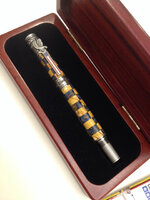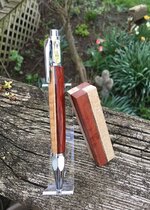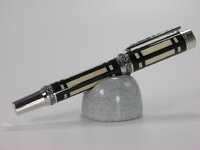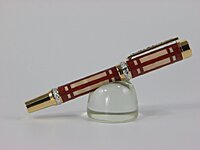You are using an out of date browser. It may not display this or other websites correctly.
You should upgrade or use an alternative browser.
You should upgrade or use an alternative browser.
Turning and sanding segmented blanks
- Thread starter Gasser
- Start date
Signed-In Members Don't See This Ad
Signed-In Members Don't See This Ad
ed4copies
Local Chapter Manager
Your question is too broad.
What species are you trying to use? OR what colors do you want next to each other?
Paduak and bloodwood are bad choices (they will color the wood next to them), but there are many other bad choices, easier to define what you want to achieve, THEN what will work to achieve it.
What species are you trying to use? OR what colors do you want next to each other?
Paduak and bloodwood are bad choices (they will color the wood next to them), but there are many other bad choices, easier to define what you want to achieve, THEN what will work to achieve it.
TG Design
Member
I have found that the dust caused by sanding may get "ground" into surrounding materials. I really notice this when I use aluminum with my segments, the fine gray dust will change the color of light wood. I've discovered a few tips along the way. Tape off sections you don't want affected. Sand in segments, don't go back and forth across color boundaries. I also have found light coats of CA will seal the surface and it won't discolor.

I noticed when I was finishing this pen, the blue dyed box elder dust from sanding caused the yellow box elder to turn gray. But once I added a thin coat of CA to seal both woods, I got clean results.
Hope that helps, post some pictures so we can see what you experiencing.

I noticed when I was finishing this pen, the blue dyed box elder dust from sanding caused the yellow box elder to turn gray. But once I added a thin coat of CA to seal both woods, I got clean results.
Hope that helps, post some pictures so we can see what you experiencing.
Last edited:
greenacres2
Member
Grinding sanding dust into blanks is what drove me to learn how to use my skew chisel to finish with. My first red/white/blue spectraply ended up red/white/pinkish gray so I learned how to sharpen and use the skew for a finish cut. Rarely use sandpaper now, just micromesh after applying a finish.
As Ed mentioned, some woods will bleed into others even just gluing them together. The pic below was going to be bloodwood & curly maple, but I knew i'd get bleeding so I put a walnut veneer between them. If i'd sanded, i'd have still gotten the bloodwood color on the maple, but with the skew all the colors stayed where they belonged.
Hope that helps.
earl
As Ed mentioned, some woods will bleed into others even just gluing them together. The pic below was going to be bloodwood & curly maple, but I knew i'd get bleeding so I put a walnut veneer between them. If i'd sanded, i'd have still gotten the bloodwood color on the maple, but with the skew all the colors stayed where they belonged.
Hope that helps.
earl
Attachments
jttheclockman
Member
I will second what Earl said. I have said this here many times when this comes up and i continue to show these two photos because they are great examples of woods that can be murder next to each other if sanded. I preach many times to learn how to use the most efficient tool in a turners arsenal and that is the skew. It really is not that hard to learn to use. There are a ton of videos on the net that show sharpening and angles of sharpening and also the presentation of the tool to the work. Just google them and you will get a real education and learn the proper way to use this tool.
But the black and white woods are Gabon ebony and Holly and the red is Bloodwood and Maple. No they will not bleed when you glue them next to each other. I use titebondII wood glue when gluing wood to wood. What I will suggest is when you turn the woods of choice down to shape with the skew to very lightly make one pass with thin CA and do not press hard. Do not clean with acetone or alchol or mineral spirits before applying CA because then you will have runs. I segment with all kinds of woods acrylics and metals and have not had any problems. Good luck and learn the skew. Alan Lacer is a good person to learn from if you can find his videos. I shape all my skews after his design and eliminates catches.
But the black and white woods are Gabon ebony and Holly and the red is Bloodwood and Maple. No they will not bleed when you glue them next to each other. I use titebondII wood glue when gluing wood to wood. What I will suggest is when you turn the woods of choice down to shape with the skew to very lightly make one pass with thin CA and do not press hard. Do not clean with acetone or alchol or mineral spirits before applying CA because then you will have runs. I segment with all kinds of woods acrylics and metals and have not had any problems. Good luck and learn the skew. Alan Lacer is a good person to learn from if you can find his videos. I shape all my skews after his design and eliminates catches.
Attachments
leehljp
Member Liaison
IF proficient with the skew, finish with the skew. However, if not, a sharp scraper will do on harder woods or woods that have been stabilized.
JT showed great wood to wood segments without sanding dust contamination. I often do brass or aluminum between segments of wood. Brass and Aluminum will contaminate from sanding but by using a sharp scraper, the wood/brass/aluminum can be brought to very smooth without the need for sanding also. Scrapers do not do so well on soft woods though, so stabilizing as mentioned earlier is a necessity.
There is a second way that "bleeding" takes place. I have not had a problem with bloodwood next to holly when using CA, but if using an acrylic finish or if I mess up a finish and use acetone to clean the messed up CA finish off, it will cause bloodwood to weep over onto the holly or other woods. Some have and probably a few people still do use liquid acrylic, devolving acrylic plastics in acetone for a different kind of finish similar to CA. These have caused bleeding between segmented woods for me. Stay away from acrylic finishes or acetone on certain woods.
The pens below were not sanded on the wood; I built up a thick layer of CA and sanded the CA, but sandpaper did not touch the wood. IN that case, the silver dots were silver solder. Silver solder smears like pencil lead when using sand paper. So the scraper was the only way for me to accomplish that.
http://www.penturners.org/photos/images/940/1_30_Pieces_of_Silver.jpg
If you care to read a little more, below is the time I posted it and the problems I ran into. It was a good while ago (2008).
http://www.penturners.org/forum/showthread.php?t=38213&highlight=30+pieces+silver
JT showed great wood to wood segments without sanding dust contamination. I often do brass or aluminum between segments of wood. Brass and Aluminum will contaminate from sanding but by using a sharp scraper, the wood/brass/aluminum can be brought to very smooth without the need for sanding also. Scrapers do not do so well on soft woods though, so stabilizing as mentioned earlier is a necessity.
There is a second way that "bleeding" takes place. I have not had a problem with bloodwood next to holly when using CA, but if using an acrylic finish or if I mess up a finish and use acetone to clean the messed up CA finish off, it will cause bloodwood to weep over onto the holly or other woods. Some have and probably a few people still do use liquid acrylic, devolving acrylic plastics in acetone for a different kind of finish similar to CA. These have caused bleeding between segmented woods for me. Stay away from acrylic finishes or acetone on certain woods.
The pens below were not sanded on the wood; I built up a thick layer of CA and sanded the CA, but sandpaper did not touch the wood. IN that case, the silver dots were silver solder. Silver solder smears like pencil lead when using sand paper. So the scraper was the only way for me to accomplish that.
http://www.penturners.org/photos/images/940/1_30_Pieces_of_Silver.jpg
If you care to read a little more, below is the time I posted it and the problems I ran into. It was a good while ago (2008).
http://www.penturners.org/forum/showthread.php?t=38213&highlight=30+pieces+silver
Last edited:



